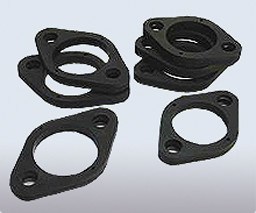
6 Tips for Working With a Rubber Molding Manufacturer
Working with a rubber manufacturer requires an understanding of their production processes and different specifications. After a good relationship has been established, you can receive products of consistent quality and have access to efficient manufacturing solutions at Clark Rubber and Plastic. Outlining project specifications, choosing the proper molding process, prioritizing quality control, and more will help to make the process more streamlined. Here are six tips for working with a rubber molding manufacturer:
Outline and Define Project Specifications
Having a clear outline of your project’s requirements will help to prevent any miscommunication and delays. Including part dimensions and the volume of parts you need in your outline will help the rubber molding manufacturer meet your production goals. Selecting the right material for the part’s purpose should also be considered because incorrect material may lead to performance issues. Other factors to keep in mind include tensile strength and temperature resistance.
Choose the Appropriate Molding Process
Different molding processes impact a part’s cost, production lead time, and overall performance. Compression molding works for smaller production runs and simpler parts. For parts with more intricate designs, transfer molding may be an appropriate choice. Injection molding is often preferred for its repeatability if you want to create large batches of parts. The manufacturers at Clark Rubber and Plastic can help you determine the optimal process for your project, as each method has different material requirements.
Look Into Quality Control
Defects throughout the manufacturing process can increase your costs and missed deadlines. Professional manufacturers have rigid quality assurance protocols to mitigate these risks. Check to see if they conduct material testing to verify that the quality of their materials meets industry standards. You can also work with a manufacturer that provides prototypes, allowing you to inspect the product before a full-scale run.
Understand Manufacturing Tooling
An understanding of tooling when working with a manufacturer is helpful because it affects costs and production quality. Two factors that influence tooling choices are the complexity of the desired part and the material it will be made from. Soft and hard tooling are the two most common types, and deciding which to use depends on the material used, its durability, and the application of the product. Choose to work with a manufacturer that offers a wide range of tooling options to meet your specific production requirements.
Plan for Rubber Molding Lead Times
A variety of factors influence product timelines, such as material availability, mold creation, and manufacturing capacity. Additional sourcing time may be necessary for specialty materials. Mold fabrication times can vary depending on the complexity of the mold. Each molding process used by Clark Rubber and Plastic also comes with its own manufacturing capacities. Injection molding works well for high-scale production runs, while compression molding creates smaller batches and will take longer to meet specific demands.
Compare Costs and Values
Choose to work with a manufacturer that operates both efficiently and produces high-quality products. Efficient use of materials creates less waste and lowers the costs associated with production. Quality components may cost more, but they tend to reduce failure rates and the need for replacement costs in the long term.
Choose Our Molding Operations
Working with the right rubber molding manufacturer will help you create reliable parts that provide lasting results. Streamline the manufacturing process by outlining your production needs and communicating them to the manufacturer. Contact Clark Rubber and Plastic today to learn about our molding services.
